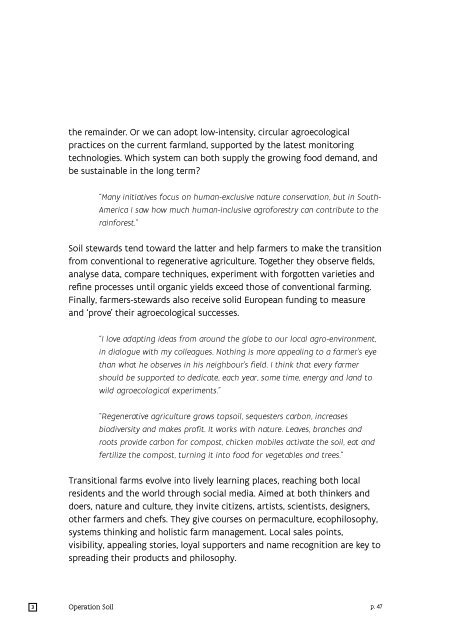The Future of Soil and Land Stewardship - An exploration of stewardship in three scenarios
- No tags were found...
Create successful ePaper yourself
Turn your PDF publications into a flip-book with our unique Google optimized e-Paper software.
the rema<strong>in</strong>der. Or we can adopt low-<strong>in</strong>tensity, circular agroecological<br />
practices on the current farml<strong>and</strong>, supported by the latest monitor<strong>in</strong>g<br />
technologies. Which system can both supply the grow<strong>in</strong>g food dem<strong>and</strong>, <strong>and</strong><br />
be susta<strong>in</strong>able <strong>in</strong> the long term?<br />
“Many <strong>in</strong>itiatives focus on human-exclusive nature conservation, but <strong>in</strong> South-<br />
America I saw how much human-<strong>in</strong>clusive agr<strong>of</strong>orestry can contribute to the<br />
ra<strong>in</strong>forest.”<br />
<strong>Soil</strong> stewards tend toward the latter <strong>and</strong> help farmers to make the transition<br />
from conventional to regenerative agriculture. Together they observe fields,<br />
analyse data, compare techniques, experiment with forgotten varieties <strong>and</strong><br />
ref<strong>in</strong>e processes until organic yields exceed those <strong>of</strong> conventional farm<strong>in</strong>g.<br />
F<strong>in</strong>ally, farmers-stewards also receive solid European fund<strong>in</strong>g to measure<br />
<strong>and</strong> ‘prove’ their agroecological successes.<br />
“I love adapt<strong>in</strong>g ideas from around the globe to our local agro-environment,<br />
<strong>in</strong> dialogue with my colleagues. Noth<strong>in</strong>g is more appeal<strong>in</strong>g to a farmer’s eye<br />
than what he observes <strong>in</strong> his neighbour’s field. I th<strong>in</strong>k that every farmer<br />
should be supported to dedicate, each year, some time, energy <strong>and</strong> l<strong>and</strong> to<br />
wild agroecological experiments.”<br />
“Regenerative agriculture grows topsoil, sequesters carbon, <strong>in</strong>creases<br />
biodiversity <strong>and</strong> makes pr<strong>of</strong>it. It works with nature. Leaves, branches <strong>and</strong><br />
roots provide carbon for compost, chicken mobiles activate the soil, eat <strong>and</strong><br />
fertilize the compost, turn<strong>in</strong>g it <strong>in</strong>to food for vegetables <strong>and</strong> trees.”<br />
Transitional farms evolve <strong>in</strong>to lively learn<strong>in</strong>g places, reach<strong>in</strong>g both local<br />
residents <strong>and</strong> the world through social media. Aimed at both th<strong>in</strong>kers <strong>and</strong><br />
doers, nature <strong>and</strong> culture, they <strong>in</strong>vite citizens, artists, scientists, designers,<br />
other farmers <strong>and</strong> chefs. <strong>The</strong>y give courses on permaculture, ecophilosophy,<br />
systems th<strong>in</strong>k<strong>in</strong>g <strong>and</strong> holistic farm management. Local sales po<strong>in</strong>ts,<br />
visibility, appeal<strong>in</strong>g stories, loyal supporters <strong>and</strong> name recognition are key to<br />
spread<strong>in</strong>g their products <strong>and</strong> philosophy.<br />
3 Operation <strong>Soil</strong> p. 47


















